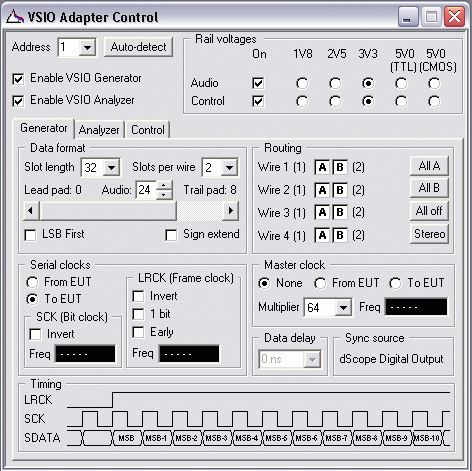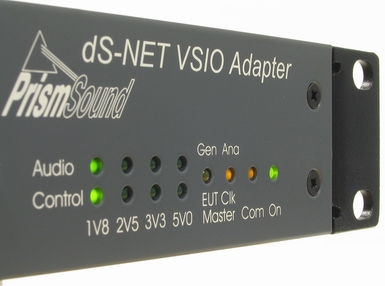The VSIO Adapter is a dS–NET peripheral primarily intended for use with the dScope Series III test and measurement system. It is an interface adapter which allows bi-directional translation between the dScope's AES3 output and input, and serial audio multiplex interfaces (for example I2S) such as are commonly found on digital audio ICs. The exact timing arrangements of the serial multiplex and its electrical properties (such as rail voltage) can be freely adjusted by the user. The VSIO Adapter can transact up to 16 multiplexed channels on a single wire, or up to eight on each of two wires, or up to four on each of four wires. Each VSIO output 'slot' (channel) can be driven from the dScope Signal Generator's A or B channel, or can be muted; any two VSIO input slots (channels) can be routed to the dScope's Signal Analyzer. Audio wordlengths between 8 and 24 bits can be positioned anywhere within a slot length of 8, 16, 24 or 32 bits; data can be transacted MSB- or LSB-first. Clock polarities and multipliers can be freely selected; frame clocks can be generated one-bit-early or single-bit-width if required; sign extension is supported. Synchronisation can be from the dScope of from the EUT (either SCK/LRCK or MCK), and EUT rail voltages of 1.8V, 2.5V, 3.3V or 5V (TTL or CMOS threshold) are supported.
VSIO Adapter Control dialogue box
All operating parameters are controlled from within the dScope software using VSIO Adapter Control dialogue box: (Alternatively, the VSIO Adapter may be controlled from a VBScript.)

Additional features
As well as carrying out the audio transcoding function, the VSIO also provides a versatile I2C / SPI control port which can be used to control component-level devices on the EUT during testing.

Connections
The VSIO Adapter is connected to the dScope with two AES3 (XLR) cables, one for the Generator and one for the Analyzer. If the EUT is to be the clock master for the Generator, an additional AES11 (XLR) cable is required for the dScope's Digital Output Reference Sync input. Three short XLR cables are therefore supplied. Short (20cm) breakout cables are supplied for connecting the Generator and Analyzer serial audio multiplexes and the control port of the VSIO Adapter to the EUT. These are terminated in in-line sockets for 0.025" square PCB posts, although spring 'hooks' are also provided to clip to IC legs etc. 1m "twist'n'flat" extension cables are also provided.
Serial control
The VSIO Adapter is controlled by the dScope using the dS–NET standard, based on the RS–232 protocol. Up to 64 dS–NET devices can be daisy-chained from the dScope's dS–NET connector using special dS–NET cables. dS–NET devices are differentiated by setting different addresses for each on rear-panel DIP switches. dS–NET devices are easily controlled from their dedicated dialogue boxes in the dScope software, or from a VBScript. The VSIO Adapter is configured and controlled using the dS-NET Setup and VSIO Control dialogue boxes (see above). |